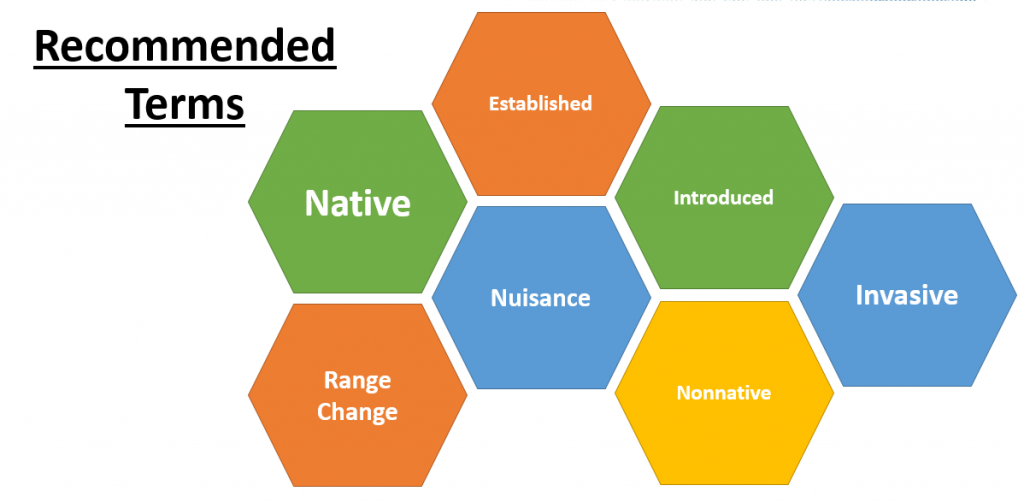Invasive species outreach is critical to the successful detection and rapid response to invasive species threats in Florida’s natural areas and urban areas. Unfortunately, due to the complex nature of invasion science, communication around invasive species is fraught with confusion, jargon, and the misuse of terms. Simplifying invasive species vocabulary is one way to reduce confusion in audiences that are mainly composed of the general public, as opposed to academic or government audiences.
The UF/IFAS Invasive Species Council has recently completed a year-long consensus-building effort to develop a list of key terms for communicating with Florida’s residents, visitors, and stakeholder groups about invasive species and their impact. Additionally, the council has produced two published works on the process and results:
- Journal of Extension, “Invasive Species Terminology: Standardizing for Stakeholder Education” (national perspective)
- UF/IFAS EDIS Publication, “Standardized Invasive Species Terminology for Effective Outreach Education” (Florida-specific perspective)
7 Terms to Use in Invasive Species Outreach

NATIVE AND NONNATIVE
A species that occurs naturally in a specified geographic area is considered “Native” and a species that does not occur naturally in a specified geographic area is considered, “Nonnative.”
It’s important to note, specifying the geographic area or ecosystem is important to improving communication and reducing confusion. For instance, while an American alligator is native to the United States it is better to be specific and say, the American alligator is native to the Southeastern United States. You can also name just the state which is relevant to your situation, such as the American alligator is native to Florida. Conversely, the American alligator is not native to the Western United States or, more specifically, the American alligator is nonnative to California.
INTRODUCED
“A species is brought to a new geographic area intentionally or unintentionally by humans.”
We have many nonnative species which have been introduced to Florida. The mere fact that they have been introduced is not a bad thing. For instance, citrus and beef cattle (and many other agricultural species) have been introduced to Florida. Similarly, many nonnative species on the Florida-Friendly Landscaping™ plant list are nonnative, introduced species.
Introduced species may or may not be able to reproduce and thrive on their own, without human intervention, and they may or may not be problematic species. Terms on this list address those abilities, such as established or invasive.
ESTABLISHED
“A species having a self-sustaining and reproducing population in a specified geographic area without the need for human intervention.”
An established species not only exists in a given area, but also grows, reproduces, and may even expand its population without human intervention. Again though, this is not inherently bad. Many nonnative landscaping plants become established in residential landscapes and adjacent unkept areas.
INVASIVE
“A species which is, 1. Nonnative to an area of consideration; 2. Introduced intentionally or unintentionally; 3. Causes or is likely to cause environmental or economic harm, or harm to humans”
Invasive species are both nonnative and established, by definition. They are also problematic in that they cause, or are likely to cause, environmental or economic harm, or harm to humans.
Because invasive species are nonnative by definition, we should avoid the term “native invasive” as it is both incorrect and confusing. A native species cannot be invasive; however, overly abundant populations or growth may be a nuisance.
NUISANCE
An individual or group of individuals of a species, but not the entire species population, that causes management issues or property damage, presents a threat to public safety, or is an annoyance.
It’s important to note that this term cannot be applied to an entire species. The term nuisance can describe plants, wildlife, insects, or other manner of living organisms.
Some native species that are commonly considered a nuisance include: wild grape, cattails, spatterdock, raccoons, and alligators.
In Florida, nuisance also has a legal definition. According to Florida Fish and Wildlife Conservation Commission, nuisance wildlife is:
Any animal or animals exhibiting behavior that:
- causes (or is about to cause) property damage
- presents a threat to public safety
- or causes an annoyance within, under or upon a building
For information about how to deal with nuisance wildlife, contact your FWC.
RANGE CHANGE
When a species’ current/existing native range grows, shrinks, or shifts over time.
This type of change may be influenced by climate-change, land development and urban sprawl, land-use changes from pasture to other uses, and more.
Some example species include: coyotes, mangroves, and armadillos.
7 Terms to Avoid in Invasive Species Outreach
- NATIVE INVASIVE: Used to describe an individual or group of individuals of a native species that act as nuisances. Use “nuisance,” instead.
- INVASIVE EXOTIC: Is redundant; used to describe an invasive species. Use “invasive,” instead.
- INVASIVE WEED: Used to describe an invasive plant. Use “invasive,” instead.
- ALIEN/FOREIGN/NONINDIGINOUS: All three terms are synonymous with “nonnative”. Use “nonnative,” instead.
Where to Learn More
The UF/IFAS Invasive Species Council has two publications that go into great detail about this subject. See, “Invasive Species Terminology: Standardizing for Stakeholder Education” for a national perspective, or “Standardized Invasive Species Terminology for Effective Outreach Education” for a Florida-specific perspective.
In Summer 2021, the Heartland CISMA offered a summer webinar series which featured a webinar on, “Let’s Talk about Invasives: Using Consistent Vocabulary with Land and Water Management Stakeholders.” You can watch that webinar by clicking the link below. At the webinar website, you will need to ‘register’ for the on-demand video.
 View a recording of “Let’s Talk About Invasive Species (Vocabulary for Stakeholders)”
View a recording of “Let’s Talk About Invasive Species (Vocabulary for Stakeholders)”
To keep up with the current and future endeavors of the UF/IFAS Invasive Species Council, bookmark their website: https://invasivespecies.ifas.ufl.edu.
Para acceder a esta comunicación en español, por favor utilice este enlace
UF/IFAS Extension is an Equal Opportunity Institution.
 4
4
